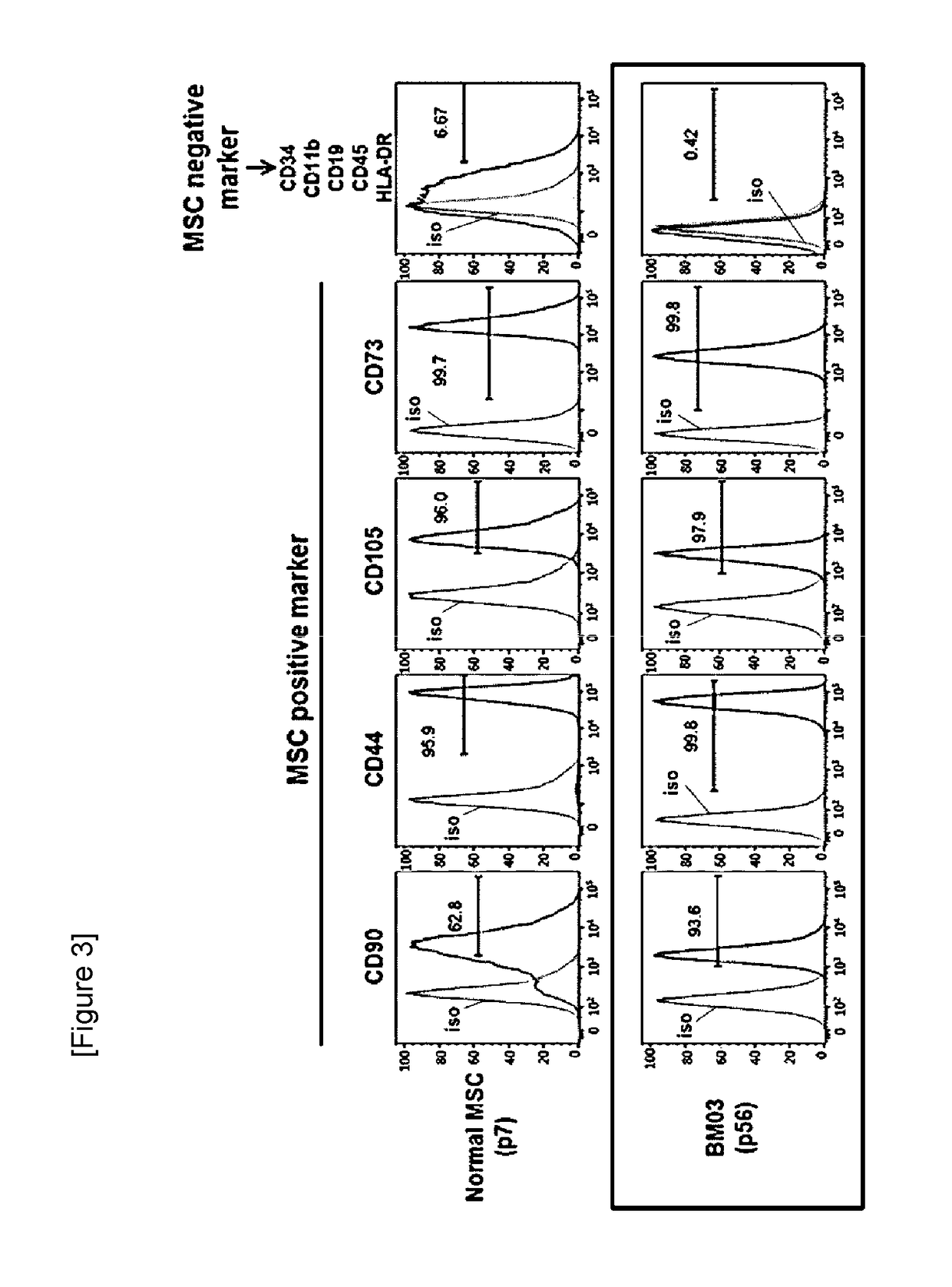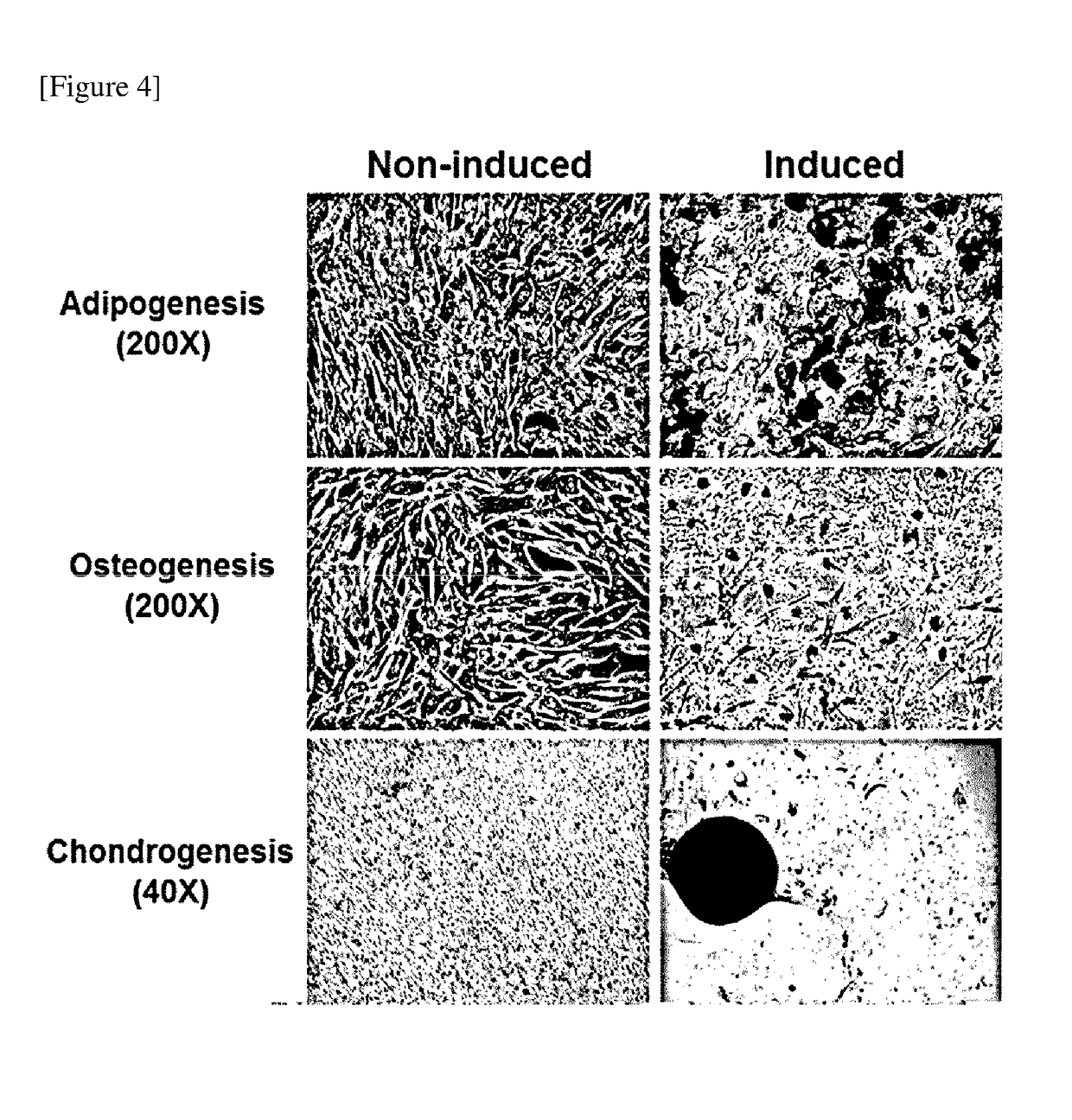Mesenchymal stem cell expressing trail and cd, and use thereof
a stem cell and mesenchymal technology, applied in the field of recombinant lentiviral vectors, can solve the problems of difficult to maintain the same effect in every production, difficult to produce large quantities, and ineffective use of mscs alone, etc., to achieve high cell proliferation rate, high safety, and the possibility of tumor formation can be blocked.
- Summary
- Abstract
- Description
- Claims
- Application Information
AI Technical Summary
Benefits of technology
Problems solved by technology
Method used
Image
Examples
example 1
on of Immortalized Mesenchymal Stem Cells (MSCs)
[0072]1-1. Preparation of Lentiviral Vectors Containing Immortalized Gene
[0073]In order to immortalize MSCs, lentiviral vectors respectively containing c-Myc and hTERT, which are immortalized genes, were prepared. Herein, a gene construct expressing the tTA protein was inserted together to use the Tet-off system.
[0074]First, a pBD lentiviral vector was prepared by substituting the EF promoter in the expression cassette of the pWPT vector (Addgene, USA) with the CMV promoter, and adding the RSV promoter to the downstream thereof.
[0075]The c-Myc gene (SEQ ID NO: 8) and thymidine kinase (TK) gene (SEQ ID NO: 6) were linked via IRES and inserted into the pBD lentiviral vector so that the expression can be regulated by the CMV promoter. The constructed vector was designated as pBD-1.
[0076]On the other hand, the hTERT gene (SEQ ID NO: 10) was inserted into the pBD lentiviral vector such that the expression can be regulated by the CMV promote...
example 2
ion of Lentivirus Containing TRAIL and CD Genes
[0089]2-1. Construction of Lentiviral Vector Containing TRAIL and CD Genes
[0090]The TRAIL gene (SEQ ID NO: 2) and the CD gene (SEQ ID NO: 4) were inserted into the prepared pBD lentiviral vector. Herein, the inserted TRAIL and CD genes were linked via IRES (internal ribosome entry site), and the expression was designed to be regulated by the TRE promoter. IRES is a ribosome binding site that allows translation to begin without the 5′-cap structure, enabling the expression of two proteins by a single mRNA. On the other hand, the TRE promoter can regulate the expression of the gene linked to the promoter depending on the presence or absence of the addition of doxycycline.
[0091]The constructed vector was designated as pBD-4, and the structure of the gene construct is shown in FIG. 2.
[0092]2-2. Production of Lentivirus Containing TRAIL and CD Genes
[0093]Using the lentiviral vector containing the TRAIL and CD genes constructed in Example 2-1...
example 3
on of MSC Infected with Lentivirus Containing TRAIL and CD Genes
[0094]3-1. Preparation of MSC Infected with Lentivirus Containing TRAIL and CD Genes
[0095]Cells expressing TRAIL and CD genes were prepared by infecting the immortalized MSCs prepared in Example 1-3 with lentivirus containing TRAIL and CD genes produced in Example 2-2. The infection was carried out by the same method as described in Examples 1-3. After the infection, 1 μg / ml of doxycycline (631311, Clontech, USA) was added to the culture medium of the stabilized cells, and the cells were cultured in a state in which the expressions of TRAIL and CD were suppressed. After the cells were stabilized, TRAIL and CD expressions were induced by culturing the cells in cell media for 72 hours from which doxycycline was removed. Then the cells expressing TRAIL on the surface are isolated using FACS.
[0096]Specifically, the cells infected with lentivirus containing TRAIL and CD genes were dispensed into FACS tubes at 5×105 cells / tub...
PUM
| Property | Measurement | Unit |
|---|---|---|
| Composition | aaaaa | aaaaa |
| Cell proliferation rate | aaaaa | aaaaa |
Abstract
Description
Claims
Application Information
 Login to View More
Login to View More - R&D
- Intellectual Property
- Life Sciences
- Materials
- Tech Scout
- Unparalleled Data Quality
- Higher Quality Content
- 60% Fewer Hallucinations
Browse by: Latest US Patents, China's latest patents, Technical Efficacy Thesaurus, Application Domain, Technology Topic, Popular Technical Reports.
© 2025 PatSnap. All rights reserved.Legal|Privacy policy|Modern Slavery Act Transparency Statement|Sitemap|About US| Contact US: help@patsnap.com



